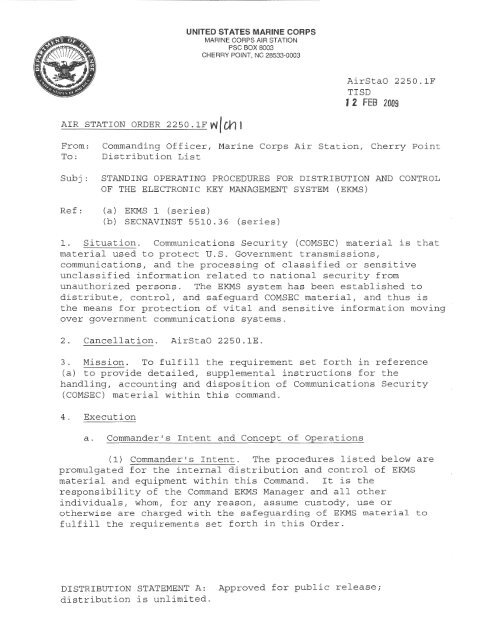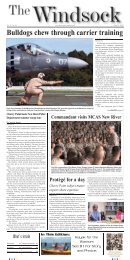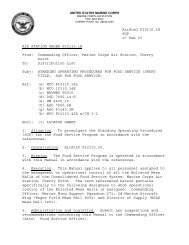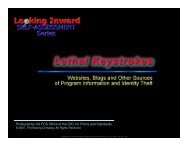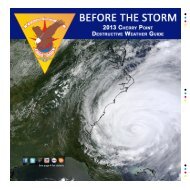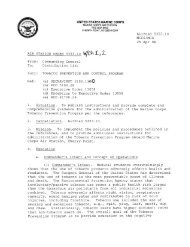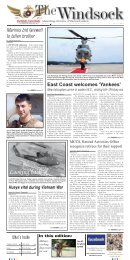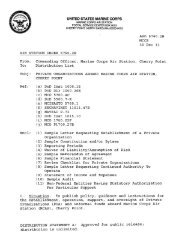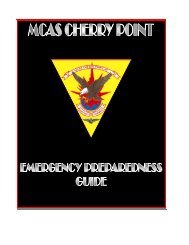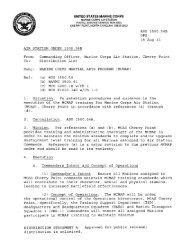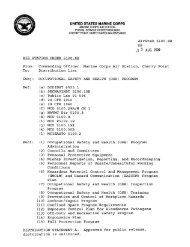J 2 FEB 2009 - MCAS Cherry Point - Marine Corps
J 2 FEB 2009 - MCAS Cherry Point - Marine Corps
J 2 FEB 2009 - MCAS Cherry Point - Marine Corps
You also want an ePaper? Increase the reach of your titles
YUMPU automatically turns print PDFs into web optimized ePapers that Google loves.
UNITED STATES MARINE CORPS<br />
MARINE CORPS AIR STATION<br />
PSC BOX8003<br />
CHERRY POINT, NC 28533-0003<br />
AirStaO 2250.1F<br />
TISD<br />
J 2 <strong>FEB</strong> <strong>2009</strong><br />
AIR STATION ORDER 2250 .lF W r c.¥l I<br />
From:<br />
To:<br />
Subj :<br />
Ref:<br />
Commanding Officer, <strong>Marine</strong> <strong>Corps</strong> Air Station, <strong>Cherry</strong> <strong>Point</strong><br />
Distribution List<br />
STANDING OPERATING PROCEDURES FOR DISTRIBUTION AND CONTROL<br />
OF THE ELECTRONIC KEY MANAGEMENT SYSTEM (EKMS)<br />
(a) EKMS 1 (series)<br />
(b) SECNAVINST 5510.36 (series)<br />
1. Situation. Communications Security (COMSEC) material is that<br />
material used to protect U.S. Government transmissions,<br />
communications, and the processing of classified or sensitive<br />
unclassified information related to national security from<br />
unauthorized persons. The EKMS system has been established to<br />
distribute, control, and safeguard COMSEC material, and thus is<br />
the means for protection of vital and sensitive information moving<br />
over government communications systems.<br />
2. Cancellation. AirStaO 2250.1E.<br />
3. Mission. To fulfill the requirement set forth in reference<br />
(a) to provide detailed, supplemental instructions for the<br />
handling, accounting and disposition of Communications Security<br />
(COMSEC) material within this command.<br />
4. Execution<br />
a. Commander's Intent and Concept of Operations<br />
(1) Commander's Intent. The procedures listed below are<br />
promulgated for the internal distribution and control of EKMS<br />
material and equipment within this Command. It is the<br />
responsibility of the Command EKMS Manager and all other<br />
individuals, whom, for any reason, assume custody, use or<br />
otherwise are charged with the safeguarding of EKMS material to<br />
fulfill the requirements set forth in this Order.<br />
DISTRIBUTION STATEMENT A:<br />
distribution is unlimited.<br />
Approved for public releasei
AirStaO 2250.1F<br />
12 <strong>FEB</strong> <strong>2009</strong><br />
(2) Concept of Operations<br />
(a) The Command will designate in writing an EKMS<br />
Manager, a primary alternate and at least one additional alternate<br />
manager who will be equally responsible for the proper<br />
administration of the Command's EKMS account. The Command EKMS<br />
Manager is responsible to the Commanding Officer for the proper<br />
management and security of all COMSEC material held at the<br />
Command. The EKMS Manager is the principal advisor to the<br />
Commanding Officer concerning EKMS matters.<br />
(b) A copy of this Order will be maintained by each<br />
Local Element (LE) and a copy made readily available to each EKMS<br />
user that assumes custody and responsibility for EKMS material and<br />
equipment.<br />
be<br />
to<br />
of<br />
(c) A COMSEC Responsibility Acknowledgement Form will<br />
executed by each individual user of EKMS material and returned<br />
the Station EKMS Manager. An example is contained in ANNEX~<br />
reference (a) .<br />
(d) Reference (a) contains detailed requirements and<br />
guidelines pertaining to the administration and physical security<br />
of EKMS. Handling of Secure Terminal Equipment (STE) and<br />
associatea4I€0V 14 cryptographic cards will be in accordance with<br />
reference (a) and Air Station Order 2200.1D:<br />
'2.2.00· I E.<br />
b. Task<br />
(1) <strong>MCAS</strong> TISD<br />
(a) Will appoint an EKMS Manager per guidelines set<br />
forth in reference (a) .<br />
(b) Will appoint an EKMS Primary Alternate Manager and<br />
at least one additional Alternate Manager and any additional<br />
Alternate Managers that may be required.<br />
(2) <strong>MCAS</strong> EKMS Manager and Alternate EKMS Managers; The<br />
EKMS Manager is responsible for all actions associated with the<br />
receipt, handling, issue, safeguarding, accounting, and<br />
disposition of COMSEC material assigned to an EKMS account and<br />
also serves as the Commanding Officer's primary advisor on EKMS<br />
account management matters. In this capacity, the EKMS Manager<br />
must:<br />
2
AirStaO 2250.1F<br />
~12 <strong>FEB</strong> <strong>2009</strong><br />
(a) Provide the Commanding Officer and other<br />
interested personnel with information about new or revised COMSEC<br />
policies and procedures and their impact on the command.<br />
(b) Maintain the command COMSEC material allowance,<br />
including conducting annual re-validation of all COMSEC material<br />
holdings.<br />
(c) Maintain proper storage and adequate physical<br />
security for the COMSEC material held by the account.<br />
(d) Provide Local Elements written guidance necessary<br />
for the accurate and secure handling/accounting of COMSEC<br />
materials.<br />
(e) Conduct training to ensure all personnel handling<br />
COMSEC material are familiar with and adhere to proper COMSEC<br />
procedures and keep Alternate Managers informed of the account<br />
status to ensure they are capable of assuming the duties of the<br />
EKMS Manager.<br />
(f) Maintain records and files as required by<br />
reference (a) and ensure prompt and accurate preparation,<br />
signature, and submission of account correspondence, message, and<br />
accounting reports.<br />
(g) Issue COMSEC material on local custody forms to<br />
properly cleared, authorized recipients who have executed a COMSEC<br />
Responsibility Acknowledgment Form.<br />
(h) Ensure that procedures are established to reassign<br />
local custody responsibility for COMSEC material held by<br />
individuals permanently leaving the command, or are departing on<br />
leave or TAD in excess of 30 days.<br />
(i) Maintain the account's portion of the command<br />
Emergency Protection Plan (EPP) per Annex~ of reference (a) .<br />
(3) <strong>MCAS</strong> Local Elements. Local E~ent personnel are<br />
responsible to their Commanding Officer for the proper management<br />
and security of all COMSEC material in their custody and<br />
responsible to their servicing EKMS account for the proper<br />
accountability, security, control, and disposition of COMSEC<br />
material issued to them. Local Elements must also:<br />
3
AirStaO 2250.1F<br />
1 2 <strong>FEB</strong> <strong>2009</strong><br />
(a) Provide their Commanding Officer, if different<br />
from their servicing EKMS account, with information about new or<br />
revised COMSEC policies and procedures and their impact on the<br />
command.<br />
(b) Follow written instructions issued by their<br />
servicing EKMS account governing the handling, accountability, and<br />
disposition of COMSEC material. Conduct and document training to<br />
ensure that all Local Element personnel handling COMSEC material<br />
are familiar with and adhere to proper COMSEC procedures.<br />
Emphasis should be placed on accountability, security and<br />
identification of improper practices.<br />
(c) Ensure proper inventory, storage and adequate<br />
physical security is maintained for all COMSEC material.<br />
(d) Maintain required records.<br />
1. Access roster for areas where COMSEC material<br />
or equipment is stored or in use signed by the Commanding Officer.<br />
2. Copy of Commanding Officer Authorization to<br />
handle COMSEC letter or roster.<br />
3. Copies of each COMSEC User Acknowledgement<br />
form for every individual authorized by the Commanding Officer to<br />
handle COMSEC material.<br />
4. Copy of annual Physical Security Evaluations<br />
(PSE) conducted by the Provost Marshal Office (PMO) .<br />
5. Copies of semi-annual inventories and all<br />
effective SF-153 custody documents.<br />
6. Daily SF-701 inventories of all COMSEC<br />
holdings by serial number.<br />
7. Documented COMSEC training events.<br />
results.<br />
8. Copies of past Local Element spot-check<br />
c. Coordinating Instructions<br />
(1) Control and Reporting. Control of COMSEC material is<br />
based on the following:<br />
4
AirStaO 2250.1F<br />
1 2 <strong>FEB</strong> <strong>2009</strong><br />
(a) A continuous chain of custody receipts using both<br />
transfer reports and local custody documents.<br />
(b) Accounting records, such as periodic inventory<br />
reports, possession reports, generation reports, conversion<br />
reports, destruction records, transfer reports, and local custody<br />
records.<br />
(c) Immediate reporting of COMSEC material incidents<br />
to ensure compromise decisions are made expeditiously by<br />
controlling/evaluating authorities.<br />
(2) Definitions<br />
(a) Electronic Key Management System (EKMS) .<br />
Interoperable collection of systems designed by the U.S.<br />
Government to automate the planning, ordering, generating,<br />
distributing, storing, filling, using, and destroying of<br />
electronic key and management of other types of COMSEC material.<br />
(b) EKMS Account. An administrative entity,<br />
identified by a six-digit account number (same number as account's<br />
EKMS ID), responsible for maintaining accountability, custody and<br />
control of COMSEC material. Also identified as or referred to as<br />
COMSEC account and/or CMS account.<br />
(c) EKMS Manager. Individual designated in writing to<br />
manage COMSEC material issued to an EKMS account. The EKMS<br />
Manager is the Commanding Officer's primary advisor on matters<br />
concerning the security and handling of COMSEC material and the<br />
associated records and reports. The Command EKMS Manager<br />
represents the Commanding Officer, <strong>MCAS</strong>, <strong>Cherry</strong> <strong>Point</strong> for COMSEC<br />
material held by the Command and, when applicable, reports routine<br />
matters to the Commanding Officer.<br />
(d) Alternate EKMS Manager(s) Individual(s)<br />
designated in writing by the Commanding Officer, and is<br />
responsible for assisting the EKMS Manager in the performance of<br />
his/her duties and assuming the duties of the EKMS Manager in<br />
his/her absence. Alternate Manager(s) share equally with the EKMS<br />
Manager the responsibility for the proper management and<br />
administration of an EKMS account.<br />
(e) Local Element. Local Elements are separate<br />
entities, units, or commands, internal or external to the parent<br />
EKMS account, that require COMSEC material. Local Element<br />
5
AirStaO 2250.1F<br />
12 <strong>FEB</strong> <strong>2009</strong><br />
personnel are designated in writing by his/her Commanding Officer.<br />
Local Elements, irrespective of command relationships, must adhere<br />
to the procedures in reference (a) and written instructions issued<br />
by their servicing EKMS Manager.<br />
(3) Access to COMSEC Material<br />
(a) Security Clearance. Access to classified COMSEC<br />
material requires a security clearance equal to or higher than the<br />
classification of the COMSEC material involved. However, access<br />
to unclassified COMSEC material does not require a security<br />
clearance.<br />
(b) Need-to-know. Access to classified COMSEC<br />
material must be restricted to properly cleared individuals whose<br />
official duties require access to COMSEC material.<br />
(c) Briefing/Indoctrination. All personnel who have<br />
access to COMSEC material must complete a COMSEC Responsibility<br />
Acknowledgement Form per Annex J of reference (a) and be properly<br />
indoctrinated regarding the sensitivity of the material, the rules<br />
for safeguarding such material, the procedures for reporting<br />
COMSEC incidents, the laws pertaining to espionage, and the rules<br />
pertaining to foreign contacts, visits, and travel per SECNAVINST<br />
5510.30 (series).<br />
(d) Written Access to COMSEC Keying Material. All<br />
personnel having access to COMSEC keying material must be<br />
authorized in writing by the Commanding Officer. Either an<br />
individual letter or an access roster may be used. Foreign<br />
nationals will not be granted access to, or provided information<br />
about, COMSEC keying material without written permission from the<br />
material's controlling authority. Access to other COMSEC material<br />
must be approved by NSA//DP02//.<br />
(e) Record all visits in the visitor register and<br />
retain the register for at least 1 year. The visitor register, at<br />
a minimum, will contain the following:<br />
1. Date/time of arrival and departure.<br />
2. Printed name and signature of visitor.<br />
3. Purpose of visit.<br />
6
AirStaO 2250.1F<br />
12 <strong>FEB</strong> <strong>2009</strong><br />
the visitor(s).<br />
4. Signature of authorized individual admitting<br />
(4) Safe Combinations. Each lock must have a combination<br />
composed of randomly selected numbers based on constraints of the<br />
manufacturer. The combination must not deliberately duplicate a<br />
combination selected for another lock within the command and must<br />
not be composed of successive numbers, numbers in a systematic<br />
sequence, or predictable sequences (e.g., birth dates, social<br />
security numbers, phone numbers) .<br />
(a) Combinations must be changed as follows:<br />
1. When the lock is initially placed in use. A<br />
manufacturer preset combination may not be used.<br />
2. When any person having knowledge of the<br />
combination no longer requires access.<br />
3. When the possibility exists that the<br />
combination has been subjected to compromise.<br />
service.<br />
4. When the combination has been taken out of<br />
5. When any repair work has been performed on the<br />
combination lock.<br />
6. At least once every 2 years or sooner as<br />
dictated by the above events.<br />
(b) Lock combinations shall be classified and<br />
safeguarded the same as the highest classification of the material<br />
being protected by the combination.<br />
(c) To provide for emergency access, a central record<br />
of the lock combinations for all COMSEC material security<br />
containers must be maintained in a security container, other than<br />
the container where COMSEC material is stored, and approved for<br />
storage of the highest classification of the material protected b y<br />
the combination locks.<br />
(d) Combinations to COMSEC material security<br />
containers must be protected as follows:<br />
7
AirStaO 2250.1F<br />
12 <strong>FEB</strong> <strong>2009</strong><br />
1. Each combination must be recorded and<br />
individually wrapped in aluminum foil and protectively packaged in<br />
a separate SF-700 combination envelope.<br />
2. Laminate each envelope in plastic (like an<br />
identification card) or seal in plastic tape.<br />
3. The name and address of the individual(s)<br />
authorized access to the combinations must be recorded on the<br />
front of the envelope.<br />
4. Individual protectively wrapped envelopes may<br />
be stored in the same single-lock security container.<br />
5. Inspect the envelopes monthly to ensure they<br />
have not been tampered with and document the inspection finding<br />
utilizing a locally generated log. Minimum data logged must be<br />
date of inspection, printed name of the individual conducting the<br />
inspection and the signature of that individual.<br />
(5) COMSEC Storage Requirements<br />
(a) Store COMSEC material separately from other<br />
classified material (e.g., in separate containers or in separate<br />
drawers).<br />
(b) Store COMSEC material only in containers and<br />
spaces approved for their storage. Unless COMSEC material is<br />
under the direct control of authorized persons, keep the<br />
containers and spaces locked.<br />
(c) Comply with applicable information on<br />
supplementary controls (e.g., guards and alarms) for safeguarding<br />
classified material in accordance with chapter 10 of reference<br />
(b) .<br />
(d) Unkeyed Controlled Cryptographic Items (CCI)<br />
and/or CCI keyed with unclassified key marked or designated<br />
CRYPTO, must be stored in a manner that affords protection against<br />
pilferage, theft, sabotage, or tampering, and ensures that access<br />
and accounting integrity are maintained.<br />
(e) Store classified, unkeyed equipment in the same<br />
manner as classified material of the same classification.<br />
8
AirStaO 2250.1F<br />
12 <strong>FEB</strong> <strong>2009</strong><br />
(f) Protect all keyed equipment based on the<br />
classification of the equipment or the keying material, whichever<br />
is higher. Additionally, ensure that procedures are in effect to<br />
prevent unauthorized use of the equipment or extraction of its<br />
key.<br />
(g) Keyed COMSEC equipment used to terminate full-time<br />
nets/circuits may be left in unattended spaces only if such spaces<br />
meet Department of the Navy criteria for open storage of<br />
information classified at the same level of the Traffic Encryption<br />
Key (TEK) used.<br />
(h) In a continuously manned facility, a security<br />
check utilizing an SF-701 checklist will be conducted once per<br />
shift, at least once every 24 hours, to ensure that all classified<br />
COMSEC information is properly safeguarded, and that physical<br />
security protection systems/devices (e.g., door lock and vent<br />
covers) are functioning properly.<br />
(i) In a non-continuously manned facility, conduct a<br />
security check utilizing an SF-701 checklist prior to departure of<br />
the last person to ensure the facility entrance door is locked and<br />
where installed, Intrusion Detection Systems (IDS) are activated.<br />
(j) Where a facility is unmanned for periods greater<br />
than 24 hours (e.g., during weekends and holidays), the facility<br />
is to be protected by an approved IDS. A check must be conducted<br />
at least once every 12 hours to ensure that all doors to the<br />
facility are locked, and that there have been no attempts to<br />
forced entry.<br />
(6) Required Forms for Storage Containers<br />
COMMerz..<br />
(a) A classifiedAcontainer information form, SF-700, A<br />
for each lock combination.must be placed on the inside of each<br />
COMSEC storage container. "-r\-\E1"'0() CD(A/ OFWE FD12M<br />
(b) A security container open/closure log, SF-702,<br />
must be maintained for each lock on a COMSEC storage container.<br />
Each opening and closure of the container must be annotated on the<br />
accompanying SF-702.<br />
(c) A Maintenance Record for Security Containers/Vault<br />
Doors, Optional Form 89, must be used as a permanent record and<br />
retained for the service life of the security container/vault<br />
door.<br />
9
AirStaO 2250.1F<br />
tz <strong>FEB</strong> <strong>2009</strong><br />
(d) Paragraph 7-10 of reference (b) requires that<br />
Commanding Officers establish procedures for end of the day<br />
security checks, utilizing the SF-701 Activity Security Checklist,<br />
to ensure that all areas which process classified information are<br />
properly secured.<br />
(7) Emergency Access to Containers and<br />
an emergency, the Commanding Officer, Security<br />
designated authority may direct the opening of<br />
security container.<br />
Combinations. In<br />
Manager or<br />
any COMSEC material<br />
(a) At least two individuals shall be present to<br />
conduct and witness the emergency opening.<br />
(b) After an emergency opening, the official who<br />
opened the container will make an after-the-fact report to the<br />
person in charge of the container.<br />
(c) The individual(s) responsible for a container<br />
opened in an emergency must immediately conduct a complete<br />
inventory of the COMSEC material, and change the combinations as<br />
soon as possible.<br />
(8) Destruction of COMSEC Material<br />
(a) Routine destruction of COMSEC material will be<br />
carried out by the <strong>MCAS</strong>, <strong>Cherry</strong> <strong>Point</strong> EKMS Manager only.<br />
(b) Hostile emergency destruction of COMSEC material<br />
will be carried out in accordance with Annex~ of reference (a).<br />
M<br />
(c) In the event of a hurricane, fire, flood, or other<br />
natural disaster, COMSEC material will be safeguarded in<br />
accordance with Annex~of<br />
5 5 1 o . 18-8"'. M<br />
{.1<br />
reference (a) and Air Station Order<br />
(9) COMSEC Incidents and Reporting Requirements. COMSEC<br />
incidents could potentially result in serious damage to national<br />
security and must be reported to the NSA. Immediately notify the<br />
EKMS Manager to report any of the following occurrences:<br />
categories:<br />
(a) COMSEC incidents are divided into three<br />
1. Cryptographic<br />
10
2. Personnel<br />
AirStaO 2250.1F<br />
f 2 <strong>FEB</strong> <strong>2009</strong><br />
3. Physical<br />
(b) Examples of Cryptographic Incidents.<br />
1. Use of COMSEC keying material that is<br />
compromised, superseded, defective, previously used (and not<br />
authorized for reuse), or the incorrect application of keying<br />
material such as use of keying material that was produced without<br />
the authorization of National Security Agency (NSA) .<br />
2. Use, without NSA authorization, of any keying<br />
material for other than its intended purpose.<br />
3. Unauthorized extension of a crypto period.<br />
4. Use or attempted use of a Key Processor beyond<br />
its mandatory re-certification date without prior approval.<br />
5. Use of COMSEC equipment having defective<br />
cryptographic logic circuits, or use of an unapproved operating<br />
procedure.<br />
6. Plain text transmission resulting from a<br />
COMSEC equipment failure or malfunction.<br />
7. Any transmission during a failure, or after an<br />
uncorrected failure that may cause improper operation of COMSEC<br />
equipment.<br />
8. Operational use of equipment without<br />
completion of required alarm check test or after failure of<br />
required alarm check test.<br />
9. Use of any COMSEC equipment or device that has ·<br />
not been approved by NSA.<br />
10. Discussion via non secure telecommunications<br />
of the details of a COMSEC equipment failure or malfunction.<br />
EKMS system.<br />
11. Detection of malicious codes (viruses) on the<br />
12. Any other occurrence that may jeopardize the<br />
crypto security of a COMSEC system.<br />
11
AirStaO 2250.1F<br />
, .2 <strong>FEB</strong> <strong>2009</strong><br />
13. Failure to return a Key Processor for Re<br />
Certification when it is due.<br />
(c) Examples of Personnel Incidents<br />
1. Known or suspected defection.<br />
2. Known or suspected espionage.<br />
3. Capture by an enemy of persons who have<br />
detailed knowledge of cryptographic logic or access to keying<br />
material.<br />
4. Unauthorized disclosure of Personal<br />
Identification Numbers (PIN) and/or passwords that are utilized on<br />
systems which allow access to COMSEC material/information.<br />
5. Unauthorized disclosure of information<br />
concerning COMSEC material.<br />
6. Attempts by unauthorized persons to effect<br />
disclosure of information concerning COMSEC material.<br />
7. For COMSEC purposes, a personnel incident does<br />
not include instances of indebtedness, spousal abuse, child abuse,<br />
substance abuse, or unauthorized absence (when there is no<br />
material missing or reason to suspect espionage or defection) .<br />
(d) Examples of Physical Incidents<br />
1. The physical loss of COMSEC material.<br />
2. The physical loss and/or compromise of KP<br />
Crypto Ignition Keys (CIKs), all KP related keys or CIKs which<br />
contain, or may contain, EKMS related information, and any floppy<br />
disk containing key or other EKMS information.<br />
3. Unauthorized access to COMSEC material by uncleared<br />
persons .<br />
4. Unauthorized access to COMSEC material by<br />
persons inappropriately cleared.<br />
5. COMSEC material discovered outside of required<br />
accountability or physical control. For example:<br />
12
A.-irStaO 2250.1F<br />
~tz <strong>FEB</strong> <strong>2009</strong><br />
~- Material reflected on a destruction report<br />
as having been destroyed and witnessed, but found not to have been<br />
destroyed.<br />
b. Material left unsecured and unattended<br />
where unauthorized persons could have had access.<br />
c. Failure to maintain required TPI for Top<br />
Secret keying material, except where a waiver has been granted.<br />
6. COMSEC material and/or EKMS components<br />
improperly packaged or shipped.<br />
7. Receipt of classified equipment/ CCI<br />
equipment, or keying material marked or designated CRYPTO with a<br />
damaged inner wrapper.<br />
8. Destruction of COMSEC material by other than<br />
authorized means.<br />
left unattended.<br />
9. COMSEC material not completely destroyed and<br />
10. Actual or attempted unauthorized maintenance<br />
(including maintenance by unqualified personnel) or the use of a<br />
maintenance procedure that deviates from established standards.<br />
cryptosystem.<br />
11. Tampering with, or penetration of, a<br />
For example:<br />
a. COMSEC material received in protective<br />
packaging which shows evidence of tampering.<br />
b. Unexplained (undocumented) removal of<br />
keying material from its protective technology.<br />
~- Known or suspected tampering with or<br />
unauthorized modification of COMSEC equipment.<br />
d. Discovery of a clandestine electronic<br />
surveillance or recording device in or near a COMSEC facility.<br />
e. Activation of the anti-tamper mechanism<br />
on 1<br />
or unexplained zeroization of 1 COMSEC equipment when other<br />
indications of unauthorized access or penetration are present.<br />
13
AirStaO 2250.1F<br />
1 2 <strong>FEB</strong> 2008<br />
12. Unauthorized copying, reproduction, or<br />
photographing of COMSEC material.<br />
13. Deliberate falsification of COMSEC records.<br />
14. Any other incident that may jeopardize the<br />
physical security of COMSEC material.<br />
(10) Practices Dangerous to Security (PDS's). The PDS's<br />
listed below, while not reportable to the national level (NSA),<br />
are practices, which have the potential to jeopardize the security<br />
of COMSEC material, if allowed to perpetuate. Report all PDS's to<br />
the EKMS Manager immediately.<br />
(a) Improperly completed accounting reports (i.e.,<br />
unauthorized signatures, missing signatures or required accounting<br />
information, incomplete short title information) .<br />
(b) Physical COMSEC keying material transferred with<br />
status markings still intact.<br />
(c) Mailing of SF-153 forms with status dates<br />
annotated for material listed.<br />
(d) Loss of a User or Master CIK.<br />
(e) CIK failure.<br />
(f) Failure of a STE terminal to re-key.<br />
(g) Utilizing a STE terminal in the secure mode with<br />
a display failure.<br />
(h) Failure to adequately secure or remove CIK from<br />
an unattended STE terminal. This is a COMSEC incident if the<br />
terminal is located in a space not approved for the open storage<br />
of material to the classification level of the installed key.<br />
(i) COMSEC material not listed on account or local<br />
element local inventory documents.<br />
(j) Late destruction of electronic COMSEC material.<br />
(k) Receipt of a package with a damaged outer<br />
wrapper, but an intact inner wrapper.<br />
14
AirStaO 2250.1F<br />
1 2 <strong>FEB</strong> <strong>2009</strong><br />
(1) Activation of the anti-tamper mechanism on, or<br />
unexplained zeroization of, COMSEC equipment, as long as no other<br />
indications of unauthorized access or penetration were present.<br />
(m)<br />
Failure to maintain OTAR/OTAT logs.<br />
(n) KP Specific non-reportable PDS's<br />
months.<br />
1. Failure to perform a KP Changeover every 3<br />
2. Failure to perform a KP Rekey annually.<br />
3. Failure to update KP CIK Pins every 6 months.<br />
4. Failure to properly maintain KP CIK/ PIN log.<br />
(o) Loss or finding of unclassified material as<br />
defined in Article 1015 of reference (a) .<br />
(11) Reportable Practices Dangerous to Security (PDS's)<br />
The following PDS's are reportable to the NSA and must be<br />
immediately reported to the EKMS Manager:<br />
(a) Premature or out-of-sequence use of key ing<br />
material before its effective date, as long as the material was<br />
not reused. If material prematurely used is reused without<br />
consent of the Controlling Authority it is a COMSEC incident.<br />
(b) Inadvertent (i.e., early) destruction of COMSEC<br />
keying material, or destruction without authorization of the<br />
controlling authority (CA) as long as destruction was properly<br />
documented .<br />
inventory.<br />
(c) Not completing and returning a Fixed Cy cle (FC)<br />
(d) Not completing a special or Combined Inventory<br />
when there is a change of Commanding Officer or change of EKMS<br />
Manager .<br />
(e) Unauthorized adjustment of preconfigured default<br />
password parameters on the EKMS Local Management Device (LMD) .<br />
15
AirStaO 2250.1F<br />
1 2 <strong>FEB</strong> <strong>2009</strong><br />
(12) Entering Amendments and Corrections to COMSEC<br />
Publications. Amendments and corrections are permanent changes to<br />
COMSEC and COMSEC-related publications, which incorporate up-todate<br />
information. All amendments to COMSEC publications will be<br />
referred to the EKMS Manager.<br />
5. Administration and Logistics. The CG, 2d MAW and tenant<br />
organization Commanding Officers concur with the contents of this<br />
Order insofar as it pertains to members of their command.<br />
6. Command and Signal<br />
a. Command. This Order is applicable to the <strong>Marine</strong> <strong>Corps</strong><br />
Reserve.<br />
b. Signal. This Order is effective the date signed.<br />
ROBERT D. CLINTON<br />
By direction<br />
DISTRIBUTION:<br />
A<br />
16
..-=<br />
'<br />
UNITED STATES MARINE CORPS<br />
MARINE CORPS AIR STATION<br />
POSTAL SERVICE CENTER BOX 8003<br />
CHERRY POINT, NORTH CAROLINA 28533-0003<br />
ASO 2250.1F Ch 1<br />
TISD<br />
1, 1 \'\~Y 2012<br />
AIR STATION ORDER 2250.1F Ch 1<br />
From:<br />
To:<br />
Subj:<br />
Commanding Officer, <strong>Marine</strong> <strong>Corps</strong> Air Station, <strong>Cherry</strong> <strong>Point</strong><br />
Distribution List<br />
STANDING OPERATING PROCEDURES FOR DISTRIBUTION AND CONTROL<br />
OF THE ELECTRONIC KEY MANAGEMENT SYSTEM (EKMS)<br />
1. Situation. To direct pen changes to the basic Order.<br />
2. Execution<br />
K".<br />
a. On page 2, paragraph 4.a. (2) (c) change "annex J" to "Annex<br />
b. On page 2, paragraph 4.a. (2) (d) change "KOV-14" to "KSV-<br />
21" and "Air Station Order 2280.1D." to "Air Station Order<br />
2280.1E."<br />
M".<br />
c. On page 3, paragraph 4.b. (2) (i) change "Annex L" to "Annex<br />
d. On page 9, paragraph 4.c. (6) (a) replace the paragraph in<br />
its entirety with "A classified computer container information<br />
form, SF-700, is required for each lock combination. The top copy<br />
of the form must be placed on the inside of each COMSEC storage<br />
container."<br />
e. On page 10, paragraph 4.c. (8) (b) change "Annex L" with<br />
"Annex M".<br />
f. On page 10, paragraph 4.c. (8) (c) change "Annex L" with<br />
"Annex M" and "Air Station Order 5510.18B." with "Air Station<br />
Order 5510.18C."<br />
3. Filing Instructions. File this Change page immediately behind<br />
the signature page of the basic Order.<br />
17


